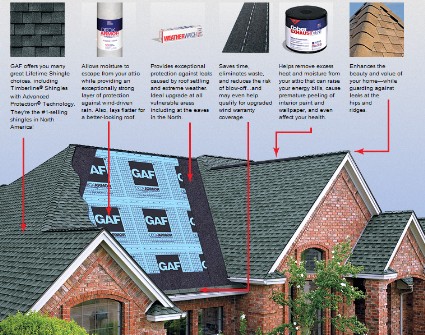Blog » Important Layers Beneath Roofing Shingles
Whatís the first thing that comes to mind when you think of roofing? You might say shingles because itís the first thing you see. However, youíve probably learned by now from reading our blog that there is much more that makes up a roofing system besides shingles.
The roof is a complicated structure with numerous parts. Sure, the appearance of your roof is important, but the quality of materials and installation dictates the level of protection it receives from outdoor elements. In order for your roof to prevent water from getting underneath the surface, each layer must be correctly placed and properly installed.
Shing les might be what you see first, but there is much more than meets the eye. There is life beneath the shingles. Oftentimes, it’s not until there is a problem, like ice dams or light penetration in the attic, that you become interested in what lies beneath.
Related: How to choose roofing shingles
Roof Structure & Layers
When we refer to the roof structure, much of the focus is on the rafters and trusses used to construct the roof support. It has several primary functions including acting as a climate barrier, protecting against fire, offering stability for the roofing system to be built upon, as well as creating exterior aesthetics of the home. The roof structure supports every other layer.
This image shows the various layers of the roofing system, including felt underlayment, ice and water shield and shingles.

Sheathing—This is also referred to as decking and provides the base for which subsequent roof layers are applied. The roof sheathing is made up of plywood or oriented strand board (OSB). These boards and sheet material are secured on top of the rafters to create the innermost layer of covering. Sheathing adds rigidity to the roof frame, and provides a surface for nails and other fasteners during shingle installation.
Underlayment— This is the first layer of waterproofing that goes down in between sheathing and shingles. Underlayment seals the roof from damaging elements like snow, ice and rain. Also referred to as a membrane, underlayment is mandatory for providing the roof with a waterproof barrier. Felt, tar paper or another form of underlayment is required for residential applications. Some homes contain an additional layer of ice and water shield.
Ice & Water Shield—This layer is designed to protect the roof where water tends to collect and cause the most damage. These areas include valleys, eaves, skylights, crickets, as well as around chimneys and vents. Not only does ice and water shield defend these water-sensitive areas, but it also provides a protective seal around nails and fasteners to prevent water from seeping through.
Roof Covering—These are the shingles, or other materials like tile and slate, which make up the outermost layer of the roof. Shingles form the barrier over other protective layers to defend against weather and outdoor elements.
Residential codes
It’s important to note that not all roofing systems consist of each of these layers. Residential building codes dictate what components are necessary for particular styles and ages of properties. In fact, there are requirements for every detail from materials to protective layers to fasteners. Although historic properties are known to have very strict regulations, don’t think that just because your home is new that there aren’t requirements and safety rules when it comes to your roofing system. Most professional roofing contractors know these regulations and codes inside and out, but it never hurts to familiarize yourself with what’s required for your own home.
Residential codes didn’t require ice and water shield for homes constructed prior to 2003. The roofing system would depend on tar paper underlayment for leak protection. Now, by code, roof pitches of 2:12 to 4:12 need double underlayment of tar paper, and those 4:12 and higher require the use of single layer tar paper. Although some roof pitches don’t necessarily require ice and water shield, our contractors put it on the entire roof as added protection.
Professional roofing contractors, quality installation
Whether you’re in need of a roofing inspection, repairs or you think it’s time to replace your roof, our experienced contractors are here to help. To schedule a free on-site estimate, contact PRS Roofing & Siding today.









